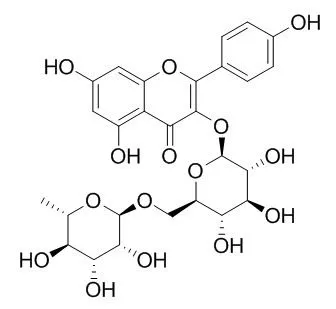| Description: |
Nicotiflorin shows potent antiglycation activity and neuroprotection effects, it has protective effects on cerebral ischemic damage, reducing memory dysfunction, energy metabolism failure and oxidative stress in multi-infarct dementia model rats. |
| Targets: |
NOS | ATPase | Calcium Channel | Potassium Channel |
| In vitro: |
| Plant Physiol Biochem. 2012 Aug;57:23-31. | | Nicotiflorin, rutin and chlorogenic acid: phenylpropanoids involved differently in quantitative resistance of potato tubers to biotrophic and necrotrophic pathogens.[Pubmed: 22677447] | Physiological and molecular mechanisms underlying quantitative resistance of plants to pathogens are still poorly understood, but could depend upon differences in the intensity or timing of general defense responses.
METHODS AND RESULTS:
This may be the case for the biosynthesis of phenolics which are known to increase after elicitation by pathogens. We thus tested the hypothesis that differences in quantitative resistance were related to differential induction of phenolics by pathogen-derived elicitors. Five potato cultivars (Solanum tuberosum, L.) spanning a range of quantitative resistance were treated with a concentrated culture filtrate (CCF) of Phytophthora infestans or purified lipopolysaccharides (LPS) from Pectobacterium atrosepticum. The kinetic of phenolics accumulation was followed and a set of typical phenolics was identified: chlorogenic acid, phenolamides and flavonols including rutin (quercetin-3-O-rutinoside) and Nicotiflorin (kaempferol-3-O-rutinoside). Our results showed that CCF but not LPS induced differential accumulation of major phenolics among cultivars. Total phenolics were related with resistance to P. atrosepticum but not to P. infestans. However, Nicotiflorin was inversely related with resistance to both pathogens. Rutin, but not Nicotiflorin, inhibited pathogen growth in vitro at physiological concentrations.
CONCLUSIONS:
These data therefore suggest that (i) several phenolics are candidate markers for quantitative resistance in potato, (ii) some of these are pathogen specific although they are produced by a general defense pathway, (iii) resistance marker molecules do not necessarily have antimicrobial activity, and (iv) the final content of these target molecules-either constitutive or induced-is a better predictor of resistance than their inducibility by pathogen elicitors. |
|
| In vivo: |
| Pharmacol Biochem Behav. 2007 Apr;86(4):741-8. | | Protective effects of Nicotiflorin on reducing memory dysfunction, energy metabolism failure and oxidative stress in multi-infarct dementia model rats.[Pubmed: 17448528] | The present study aimed to determine whether Nicotiflorin, a natural flavonoid extracted from coronal of Carthamus tinctorius, has a protective effect on cerebral multi-infarct dementia in rats.
METHODS AND RESULTS:
The multi-infarct dementia model rats were prepared by injecting man-made micro-thrombi into the right hemisphere. The administration groups were treated once daily with 30, 60 and 120 mg/kg Nicotiflorin (i.g.) from 5 days before ischemia operation to 3 days after the operation for biochemical examination, 10 days for Morris water maze study and morphological observations and 20 days for eight-arm radial maze task. 2,3,5-triphenyltetrazolium chloride (TTC) staining showed that infarct volume of each Nicotiflorin administration group was much smaller than that of vehicle-treated multi-infarct dementia group, and hematoxylin and eosin (HE) staining showed that histopathological abnormalities of each Nicotiflorin group were also much lighter than that of vehicle-treated multi-infarct dementia group. Each Nicotiflorin group showed much better spatial memory performance in Morris water maze tests and eight-arm radial maze task compared with the vehicle-treated multi-infarct dementia group, significantly attenuated the elevation of lactic acid and malondialdehyde (MDA) contents and the decrease in lactate dehydrogenase (LDH), Na(+)K(+)ATPase, Ca(2+)Mg(2+)ATPase and superoxide dismutase (SOD) activity in the brain tissue which was composed of striatum, cortex and hippocampus of the ischemia hemisphere at day 3 after ischemia operation.
CONCLUSIONS:
These results suggest that Nicotiflorin has protective effects on reducing memory dysfunction, energy metabolism failure and oxidative stress in multi-infarct dementia model rats. |
|






 Cell. 2018 Jan 11;172(1-2):249-261.e12. doi: 10.1016/j.cell.2017.12.019.IF=36.216(2019)
Cell. 2018 Jan 11;172(1-2):249-261.e12. doi: 10.1016/j.cell.2017.12.019.IF=36.216(2019) Cell Metab. 2020 Mar 3;31(3):534-548.e5. doi: 10.1016/j.cmet.2020.01.002.IF=22.415(2019)
Cell Metab. 2020 Mar 3;31(3):534-548.e5. doi: 10.1016/j.cmet.2020.01.002.IF=22.415(2019) Mol Cell. 2017 Nov 16;68(4):673-685.e6. doi: 10.1016/j.molcel.2017.10.022.IF=14.548(2019)
Mol Cell. 2017 Nov 16;68(4):673-685.e6. doi: 10.1016/j.molcel.2017.10.022.IF=14.548(2019)